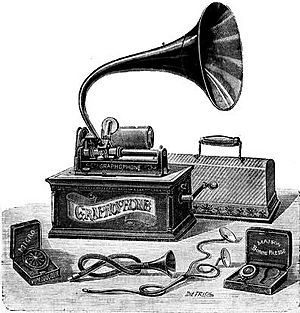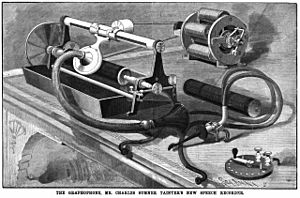Graphophone facts for kids
The Graphophone was an improved version of the phonograph. It was a machine that could record and play sounds. It was invented at the Volta Laboratory in Washington, D.C., United States. This lab was started by Alexander Graham Bell.
Over time, different companies owned the Graphophone name. These included the Volta Graphophone Company and the American Graphophone Company. Eventually, the Columbia Phonograph Company took over. Today, this company is known as Columbia Records. All these companies made or sold Graphophones.
Contents
How the Graphophone Was Developed
It took five years of hard work to create the Graphophone. Researchers like Charles Sumner Tainter and Chichester Bell worked at the Volta Laboratory. Their goal was to make a better sound machine than Thomas Edison's Phonograph.
New Ways to Record Sound
The researchers tried new ways to record sound as early as 1881. Edison's Phonograph recorded sound by cutting grooves up and down. But the Graphophone team experimented with cutting grooves side to side. This was like a "zig zag" pattern.
Even though cylinder Graphophones didn't use this side-to-side method much, it was very important. It later became the main way to record music on record discs.
Better Recording Materials
Bell and Tainter also made a big improvement with their recording material. They used wax-coated cardboard cylinders. Edison's machine used a thin sheet of tinfoil. This tinfoil could easily get damaged when put on or taken off.
Using wax was much better. It made the sound clearer and the recordings lasted longer. Wax cylinders were also easier to handle. They allowed for longer recordings too.
Improved Power for Playback
The first Graphophones used foot pedals to make the recordings spin. Later, they used wind-up clockwork motors. Finally, they switched to electric motors. This was much easier than the hand crank used on Edison's Phonograph.
Bringing the Graphophone to People
By 1885, the Volta Laboratory team knew they had useful inventions. They applied for patents and looked for people to invest money. The Volta Graphophone Company was started on January 6, 1886. Its job was to manage the patents and sell the new sound machines. One of these machines later became the first Dictaphone.
The American Graphophone Company
After the Volta team showed their machines in Washington, D.C., some business people from Philadelphia got interested. They created the American Graphophone Company on March 28, 1887. This company was made to produce and sell the Graphophones.
The Volta Graphophone Company then joined with American Graphophone. This company later grew into Columbia Records. The Howe Machine Factory in Bridgeport, Connecticut, which made sewing machines, became the Graphophone factory. Charles Tainter helped set up the manufacturing there. The small Bridgeport factory eventually became the Dictaphone Corporation.
How the Graphophone Evolved
Soon after the American Graphophone Company was formed, a man named Jesse H. Lippincott bought control of it. He also bought the rights to the Graphophone and its patents. He invested a lot of money into the company.
Lippincott also bought Edison's Speaking Phonograph Company. He then created the North American Phonograph Company in 1888. This company was meant to sell both the Graphophone and Edison's Phonograph across the country.
Jesse Lippincott set up a network of local companies. These companies would rent out Phonographs and Graphophones. They were mainly used as dictation machines for businesses. However, the machines had some problems, and people who wrote notes (like stenographers) didn't always like them. This led to the company going bankrupt in the early 1890s.
Coin-Operated Machines
In 1893, Tainter developed a coin-operated Graphophone. This machine, U.S. Patent 506,348, was made to compete with other coin-operated phonographs. These were popular for entertainment.
Columbia Records and the Graphophone
In 1889, the Columbia Phonograph Company started using the name Graphophone for its own version of the Phonograph. This company had originally been licensed by American Graphophone to sell Graphophones in Washington D.C.
The Columbia Phonograph Company eventually bought the American Graphophone Company in 1893. In 1906, the American Graphophone company changed its name to Columbia Graphophone Company. This showed its connection to Columbia.
Later, in 1923, Louis Sterling bought Columbia Phonograph Co. He reorganized it, and this led to the creation of the famous record company, Columbia Records.
Early Graphophones could play Edison's cylinders. Some models, like the Type K electric, could record and play the older Bell and Tainter cylinders. The name Graphophone was used by Columbia for its disc machines for many years. A similar name, Grafonola, was used for machines with internal horns.
See also
 In Spanish: Grafófono para niños
In Spanish: Grafófono para niños



